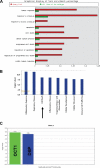Systems analysis of immune responses in Marek's disease virus-infected chickens identifies a gene involved in susceptibility and highlights a possible novel pathogenicity mechanism
- PMID: 21865384
- PMCID: PMC3194948
- DOI: 10.1128/JVI.05499-11
Systems analysis of immune responses in Marek's disease virus-infected chickens identifies a gene involved in susceptibility and highlights a possible novel pathogenicity mechanism
Abstract
Marek's disease virus (MDV) is a highly contagious oncogenic alphaherpesvirus that causes disease that is both a cancer model and a continuing threat to the world's poultry industry. This comprehensive gene expression study analyzes the host response to infection in both resistant and susceptible lines of chickens and inherent expression differences between the two lines following the infection of the host. A novel pathogenicity mechanism, involving the downregulation of genes containing HIC1 transcription factor binding sites as early as 4 days postinfection, was suggested from this analysis. HIC1 drives antitumor mechanisms, suggesting that MDV infection switches off genes involved in antitumor regulation several days before the expression of the MDV oncogene meq. The comparison of the gene expression data to previous QTL data identified several genes as candidates for involvement in resistance to MD. One of these genes, IRG1, was confirmed by single nucleotide polymorphism analysis to be involved in susceptibility. Its precise mechanism remains to be elucidated, although the analysis of gene expression data suggests it has a role in apoptosis. Understanding which genes are involved in susceptibility/resistance to MD and defining the pathological mechanisms of the disease gives us a much greater ability to try to reduce the incidence of this virus, which is costly to the poultry industry in terms of both animal welfare and economics.
Figures





Similar articles
-
Marek's disease virus-induced immunosuppression: array analysis of chicken immune response gene expression profiling.Viral Immunol. 2010 Jun;23(3):309-19. doi: 10.1089/vim.2009.0079. Viral Immunol. 2010. PMID: 20565294
-
Gene expression profiling in rMd5- and rMd5deltameq-infected chickens.Avian Dis. 2011 Sep;55(3):358-67. doi: 10.1637/9608-120610-Reg.1. Avian Dis. 2011. PMID: 22017031
-
Comparative analysis of Marek's disease virus (MDV) glycoprotein-, lytic antigen pp38- and transformation antigen Meq-encoding genes: association of meq mutations with MDVs of high virulence.Vet Microbiol. 2004 Sep 8;102(3-4):147-67. doi: 10.1016/j.vetmic.2004.06.007. Vet Microbiol. 2004. PMID: 15327791
-
Transcriptome and proteome profiling of host responses to Marek's disease virus in chickens.Vet Immunol Immunopathol. 2010 Dec 15;138(4):292-302. doi: 10.1016/j.vetimm.2010.10.007. Epub 2010 Oct 12. Vet Immunol Immunopathol. 2010. PMID: 21067815 Review.
-
Use of Marek's disease vaccines: could they be driving the virus to increasing virulence?Expert Rev Vaccines. 2005 Feb;4(1):77-88. doi: 10.1586/14760584.4.1.77. Expert Rev Vaccines. 2005. PMID: 15757475 Review.
Cited by
-
Itaconate inhibits TET DNA dioxygenases to dampen inflammatory responses.Nat Cell Biol. 2022 Mar;24(3):353-363. doi: 10.1038/s41556-022-00853-8. Epub 2022 Mar 7. Nat Cell Biol. 2022. PMID: 35256775 Free PMC article.
-
Epigenetic Factor MicroRNAs Likely Mediate Vaccine Protection Efficacy against Lymphomas in Response to Tumor Virus Infection in Chickens through Target Gene Involved Signaling Pathways.Vet Sci. 2024 Mar 22;11(4):139. doi: 10.3390/vetsci11040139. Vet Sci. 2024. PMID: 38668407 Free PMC article.
-
Analysis of the early immune response to infection by infectious bursal disease virus in chickens differing in their resistance to the disease.J Virol. 2015 Mar;89(5):2469-82. doi: 10.1128/JVI.02828-14. Epub 2014 Dec 10. J Virol. 2015. PMID: 25505077 Free PMC article.
-
The Role of Dendritic Cells in the Host Response to Marek's Disease Virus (MDV) as Shown by Transcriptomic Analysis of Susceptible and Resistant Birds.Pathogens. 2022 Nov 13;11(11):1340. doi: 10.3390/pathogens11111340. Pathogens. 2022. PMID: 36422592 Free PMC article.
-
Transcriptional Profiles Associated with Marek's Disease Virus in Bursa and Spleen Lymphocytes Reveal Contrasting Immune Responses during Early Cytolytic Infection.Viruses. 2020 Mar 23;12(3):354. doi: 10.3390/v12030354. Viruses. 2020. PMID: 32210095 Free PMC article.
References
-
- Affymetrix 2005. Guide to probe logarithmic intensity error (PLIER) estimation. Affymetrix I, Santa Clara, CA
-
- Asmundson V. S., Biely J. 1932. Inheritance of resistance to fowl paralysis (neurolymphomatosis gallinarum). I. Differences in susceptibility. Can. J. Res. 6:171–176 - PubMed
-
- Baigent S. J., Davison F. 2004. Marek's disease virus: biology and life cycle, p. 62–77 In Davison F., Nair V. (ed.), Marek's disease: an evolving problem. Elsevier Academic Press, London, United Kingdom
-
- Brownlie R., et al. 2009. Chicken TLR21 acts as a functional homologue to mammalian TLR9 in the recognition of CpG oligodeoxynucleotides. Mol. Immunol. 46:3163–3170 - PubMed
Publication types
MeSH terms
Substances
Grants and funding
- BB/D523578/2/BB_/Biotechnology and Biological Sciences Research Council/United Kingdom
- BB/G001642/1/BB_/Biotechnology and Biological Sciences Research Council/United Kingdom
- BB/D013704/2/BB_/Biotechnology and Biological Sciences Research Council/United Kingdom
- BB/D013704/1/BB_/Biotechnology and Biological Sciences Research Council/United Kingdom
- BB/D010705/1/BB_/Biotechnology and Biological Sciences Research Council/United Kingdom
LinkOut - more resources
Full Text Sources
Other Literature Sources

